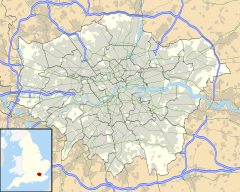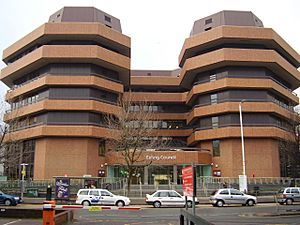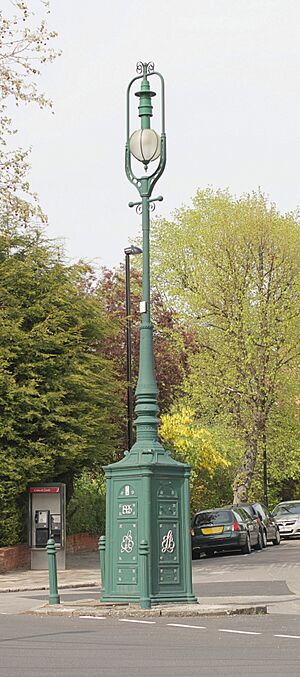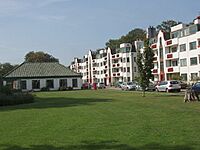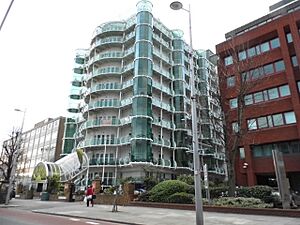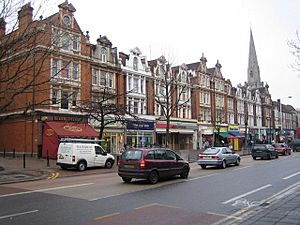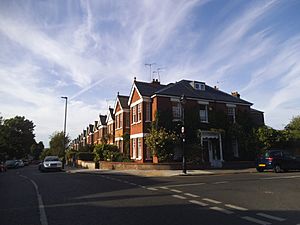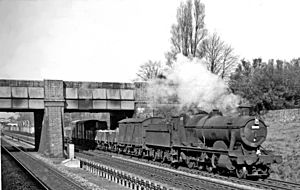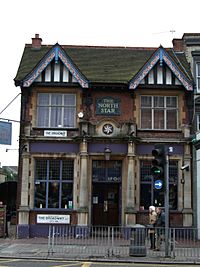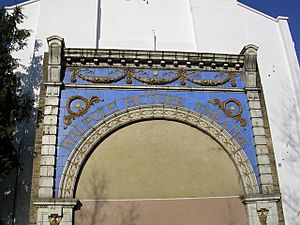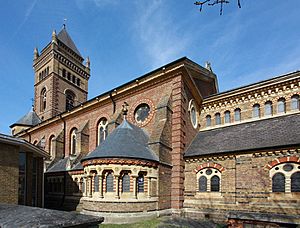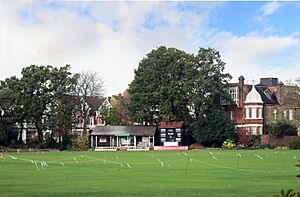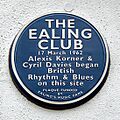Ealing facts for kids
Quick facts for kids Ealing |
|
|---|---|
 Ealing Town Hall |
|
| Population | 85,014 (2011 Census) |
| OS grid reference | TQ175805 |
| • Charing Cross | 7.5 mi (12.1 km) E |
| London borough | |
| Ceremonial county | Greater London |
| Region | |
| Country | England |
| Sovereign state | United Kingdom |
| Post town | LONDON |
| Postcode district | W5, W13 |
| Postcode district | NW10 |
| Dialling code | 020 |
| Police | Metropolitan |
| Fire | London |
| Ambulance | London |
| EU Parliament | London |
| UK Parliament |
|
| London Assembly |
|
Ealing (pronounced EE-ling) is a lively district in West London, England. It's about 12 kilometers (7.5 miles) west of central London. Ealing is the main hub of the London Borough of Ealing. It is also a major business and shopping area.
Long ago, Ealing was a small village in the countryside. It was part of the county of Middlesex. As London grew, Ealing changed. Better transport, like the railway in 1838, helped it grow. People started growing food for London. By 1902, Ealing was called the "Queen of the Suburbs." This was because it had lots of green spaces. It was also a good mix of city and country life.
Ealing grew a lot in the 20th century. It became a municipal borough in 1901. Then, in 1965, it became part of Greater London. Today, Ealing is a busy place for shops and businesses. It also has a lively night-time scene. Some parts of Ealing, like Pitshanger, still feel like quiet villages. Ealing's town centre is often called Ealing Broadway. This is the name of both a train station and a shopping centre.
Most of Ealing uses the W5 postcode. Areas like West Ealing use W13. Some parts, like West Twyford, use NW10. In 2011, Ealing had about 85,014 people living there.
Contents
Ealing's History
What's in a Name?
The name Ealing comes from an old Saxon tribe called the Gillingas. This tribe was mentioned around the year 700. The Gillingas were named after a leader called Gilla. The name of the place appeared as Yllinges around 1170. Later, in 1553, it was called Elyng.
Early Days in Ealing
Archaeologists have found signs that Neanderthal humans lived in Ealing. This was during the Stone Age, hundreds of thousands of years ago. They used special stone tools. Later, during the Iron Age, some old coins were found. These coins suggest that people lived and traded here long ago.
The Church of St. Mary's is Ealing's parish church. The Bishop of London chose its priest since about 1127. The church needed many repairs over the years. In 1729, its steeple fell down, destroying the church. It had to be rebuilt. In the 12th century, Ealing was part of a large forest. This forest covered most of the county of Middlesex.
The oldest English census we have is from Ealing in 1599. It listed all 85 households in the village. It showed the names, ages, and jobs of everyone living there. This old list is kept at The National Archives.
People lived in different parts of the parish. Some lived near the church on what is now St. Mary's Road. Others lived in areas like Little Ealing and Haven Green. Ealing had many farms. They grew crops like wheat, barley, and rye. They also raised cows, sheep, and chickens.
Ealing had fruit orchards as early as 1540. These orchards grew more common over time. By 1767, one field in West Ealing had over 1,000 fruit trees. Most of these were apple trees.
In 1318, Ealing had a windmill. It was rebuilt several times. A fair was held on Ealing Green in 1822. It was a popular event that attracted many people. The fair continued until 1880.
The area also included Old Brentford. This part had many fisheries on the River Thames. In 1257, the king ordered the Bishop to provide thousands of fish each year. This shows how important fishing was in the area.
Ealing Becomes a London Suburb
Moving heavy goods was hard before good roads. Roads were often muddy and hard to use. But then, the Toll Road Act helped build better roads. The old Oxford Road, now Uxbridge Road, became very busy. It ran through the middle of Ealing.
Wealthy Londoners started to see Ealing as a nice place to visit. It was away from the city's smoke and smells. In 1800, architect John Soane bought Pitzhanger Manor. He used it as a green place to entertain friends. Soon after, in 1801, the Duke of Kent bought a house here. More rich Londoners followed, wanting to live closer to London. Spencer Perceval, a British prime minister, lived in Ealing. Before this, Ealing was mostly farms and open countryside.
Old Inns and Pubs
As London grew, more goods moved in and out. Horses could only travel a few miles a day. So, many inns were built along the Uxbridge Road. These inns were places where horses could be changed. Travelers could also rest and eat. This made the road popular with highwaymen. Famous inns in Ealing included The Feathers and The Green Man.
At one time, there were two pubs called The Old Hat(s). They were on either side of a toll gate in West Ealing. When the toll gate was removed, one pub was renamed The Halfway House.
Ealing's Growth and Development
As London grew, Ealing became a place for market gardens. These needed many workers. In the 1850s, travel got better with the Great Western Railway and canals. Villages started to grow into towns. Ealing began to be called the "Queen of the Suburbs."
Mount Castle Tower was an old building on Hanger Hill. It was used as a tea-stop in the 1800s. It was taken down in 1881 to build Fox's Reservoir. This reservoir helped provide good water to Ealing. This made Ealing even more attractive to live in.
Mount Castle Tower was also important for science. It was a key point in a survey that linked the Royal Greenwich Observatory with the Paris Observatory. This survey helped map the land accurately.
Modern Victorian Ealing
The 19th century brought big changes to Ealing. The Great Western Railway was built in the 1830s. A railway station opened in 1879. In the following years, many new homes were built. These were mainly semi-detached houses for middle-class families. Gas and electricity were also brought to Ealing.
Better transport, like horse buses and trains, made it easier to work in London. People could live in the countryside while working in the city. Some green areas were saved as public parks. These include Lammas Park and Ealing Common. Pitzhanger Manor and its large grounds were sold to the council in 1901. These grounds became Walpole Park.
During the Victorian period, Ealing became a town. This meant building good roads and public buildings. To keep people healthy, Ealing got London's first modern drainage and sewage systems. Drinking fountains were also put up. Ealing Broadway became a major shopping area.
Charles Jones was a key person in Ealing's development. He was the Borough Surveyor from 1863 to 1913. He helped plant trees on Ealing Common. He also designed Ealing Town Hall. He helped turn the Walpole estate into a public park.
The "Queen of the Suburbs"
In 1901, Ealing became a municipal borough. Walpole Park opened, and electric trams started running on Uxbridge Road. The tram company also had to install modern street lighting. A power station was built to supply electricity for more streetlights.
Nikolaus Pevsner, a famous historian, said that the area around Mount Park Road showed why Ealing was called the "Queen of the Suburbs." Ealing quickly became a modern and stylish country town. It was free from the dirt of London, but still close by. Charles Jones used the term "Queen of the Suburbs" in his book in 1902. He wanted to show that Ealing was known for its beautiful homes and gardens. Many of these old houses still exist today.
In the early 1900s, the Brentham Garden Suburb was built. Later, in the 1930s, Ealing Village apartments were built. These buildings are now Grade II listed.
In 1965, Ealing Town Hall became the main office for the new London Borough of Ealing. In 1984, the Ealing Broadway Centre was finished. It includes a shopping centre and a town square.
Ealing's Location
Ealing is in the heart of West London. The A406 North Circular Road, London runs through the east side of Ealing. The M4 motorway is also close by to the south.
Ealing is less than two miles from the River Thames. It has many parks and open spaces. These include Ealing Common, Walpole, Lammas, and Pitshanger Parks. The River Brent flows through Pitshanger Park.
 |
NW: Greenford, Perivale | Alperton, Perivale | NE: Park Royal |  |
| Hanwell, West Ealing | Acton | |||
| SW: Boston Manor | Brentford, Gunnersbury | SE: Chiswick, South Acton |
Who Lives in Ealing?
In 2011, the largest group of people in Ealing Broadway were White British (45%). The second largest group was Other White (21%). After English, the most common languages spoken were Polish, French, and Japanese. The nearby Hanger Hill area has London's largest Japanese community.
Getting Around Ealing
Ealing has good transport links. Ealing Broadway station is on the Great Western Main Line and the London Underground. It's in London fare zone 3. There are five other tube stations in Ealing: North Ealing, South Ealing, Hanger Lane, Northfields, and Park Royal.
The Piccadilly line serves some stations, and the Central line serves others. The District line also serves Ealing Broadway and Ealing Common. National Rail trains also stop at Ealing Broadway and West Ealing.
In 2022, Ealing Broadway and West Ealing stations became part of the Elizabeth line. Ealing Broadway is also served by 18 bus routes, including night buses.
Economy and Culture
Ealing has many pubs and restaurants. These places make Ealing a lively spot, especially at night. They are mostly found on The Mall, The Broadway, and New Broadway.
Ealing Studios: Home of Film
Ealing is famous for its film studios. They are the oldest in the world. They are especially known for the "Ealing comedies." These include classic films like Kind Hearts and Coronets and The Ladykillers.
The BBC took over the studios in 1955. This meant Ealing locations appeared in TV shows. These included Doctor Who and Monty Python's Flying Circus. More recently, the studios have been used for films like Notting Hill and The Importance of Being Earnest. St Trinian's was also made here.
Ealing Studios was also the set for the popular TV series Downton Abbey. The scenes showing the servants' areas were filmed there. In 2015, the Duchess of Cambridge visited the studios. She met the cast and crew of Downton Abbey.
For 14 years, Ealing did not have a cinema. The Ealing Empire closed in 2008. But in 2022, the Ealing Project opened. It's a community space with a cinema. A new Art Deco apartment and cinema block called 'Filmworks' is also being built. It will have a Picturehouse cinema.
Ealing also has a theatre called The Questors Theatre on Mattock Lane.
Places of Worship
St Peter's Church, Ealing is considered a beautiful building in Ealing. The old parish church is St Mary's. Ealing Abbey was started by Catholic Benedictine monks in 1897. It is a working monastery.
Ealing has over fifteen churches. This includes Our Lady Mother of the Church, a Polish Catholic church. There are two well-known synagogues. The Ealing United Synagogue is Orthodox. The Ealing Liberal Synagogue was founded in 1943. Nearby areas like Acton and Southall have mosques. Southall also has large Muslim, Hindu, and Sikh communities.
Music in Ealing
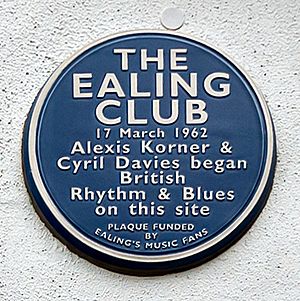
Famous musicians like Mick Jagger and Keith Richards of the Rolling Stones met Brian Jones in 1962. This happened at the Ealing Jazz Club, near Ealing Broadway station. Other artists like Rod Stewart also played there. The Jazz Club is now a nightclub called the Red Room.
The Beatles visited West Ealing in 1964. They filmed parts of their movie ‘A Hard Day’s Night’ there. Dusty Springfield lived in West Ealing as a teenager.
The band Brand New Heavies formed in Ealing in 1985. An article in the Huffington Post in 2013 said Ealing could be called the home of rock music. This is because of the Ealing Jazz Club's influence on British musicians.
Britney Spears filmed part of her music video for "Criminal" in Ealing. Mitch Mitchell of the Jimi Hendrix Experience was born in Ealing in 1947. The band White Lies are also from Ealing.
Sports in Ealing
Ealing is home to Ealing Trailfinders Rugby Club. Ealing Town Football Club was started in 2008. Other local football clubs include Old Actonians youth FC and Pitshanger youth FC. Non-League football club Hanwell Town F.C. also plays in local leagues.
Gaelic Games are popular in Ealing's Irish community. Clubs like St. Joseph's GAA are successful.
Ealing has a running club called Ealing, Southall & Middlesex AC. It was founded in 1920. Olympic champion Kelly Holmes was a member. ESC D3 Triathlon Club is also based in Ealing. Its members compete in triathlons.
Cricket in Ealing
Ealing Cricket Club started in 1870. Their main ground is on Corfton Road. Ealing CC has won the Middlesex County Cricket League championship 11 times. They have six senior teams and a women's team. They also have a junior training section.
Ealing's Festivals
Ealing hosts several yearly festivals. The Jazz Festival is held in Walpole Park. The annual Beer Festival is organized by the Campaign for Real Ale. It started at Ealing Town Hall but moved to Walpole Park because it became so popular. It offers over 200 different beers.
Other festivals include:
- Ealing Music and Film Valentine Festival
- Ealing Beer Festival
- Blues Festival
- Comedy Festival
- Jazz Festival
- Opera in the Park
Ealing in Stories and Books
- The house where Reggie Perrin lived in the TV show ‘The Fall and Rise of Reginald Perrin’ was in Hanger Hill.
- Ealing was the setting for the children's comedy show Rentaghost.
- A blue plaque in the Ealing Broadway Centre remembers Charles Hamilton. He created the famous character Billy Bunter.
- In James Hilton's book Goodbye, Mr Chips, Katherine lived with her aunt in Ealing.
- Aldous Huxley's book Brave New World mentions Ealing.
- The main character in Dorothy Koomson's book Marshmallows for Breakfast lived in Ealing.
- George Bowling in George Orwell's Coming Up for Air lived in Ealing.
- The police station in the TV show Dixon of Dock Green was the old Ealing police station.
- In H. G. Wells' The War of the Worlds, aliens attack Ealing.
- Thomas Merton wrote about living in Ealing in his book Seven Story Mountain.
- Keith Stewart in Nevil Shute's Trustee from the Toolroom lives in West Ealing.
- Jenni Fortune in Sebastian Faulks' A Week in December lives in Drayton Green, West Ealing.
- In Doctor Who and related shows:
- The John Sanders department store in Ealing was used for scenes in Spearhead from Space.
- In Survival, the Seventh Doctor and Ace visit Ealing.
- The spin-off series The Sarah Jane Adventures was set in Ealing.
- Companion Clara Oswald lives in South Ealing.
Languages Spoken
The Guardian newspaper has called Ealing "the nation's hotspot for Polish speaking."
After English, the most common languages spoken in Ealing in 2017 were Polish (8%), Punjabi (8%), Somali (7%), Arabic (6%), Urdu (5%), and Tamil (4%). The number of Polish-speaking children increased the most between 2012 and 2017.
Ealing in the Media
Westside 89.6FM is a community radio station for the borough. It broadcasts from nearby Hanwell. Blast Radio is the student radio station for the University of West London. It broadcasts from Ealing Studios.
EALING.NEWS is a local online newspaper. It covers news from all of Ealing's towns. It started in July 2022.
Images for kids
See also
 In Spanish: Barrio de Ealing (Londres) para niños
In Spanish: Barrio de Ealing (Londres) para niños


